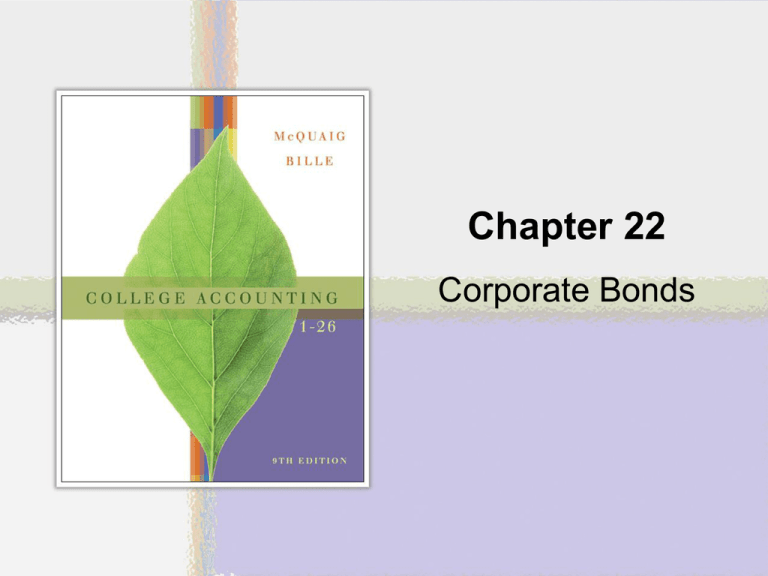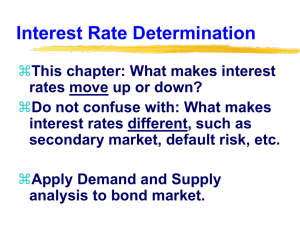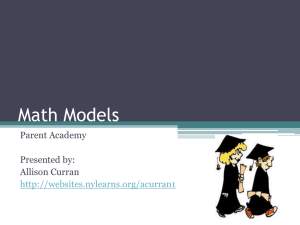
Chapter 22
Corporate Bonds
Ways That Corporations
Can Raise Funds
• Issuing common stock
• Issuing preferred
stock
• Issuing bonds
© Royalty Free C Squared Studios/ Getty Images
Copyright © Houghton Mifflin Company. All rights reserved.
22 | 2
What Is a Bond?
A long-term obligation that provides capital
• Bonds are issued by a company to raise capital.
• Bonds are liabilities to the issuing company.
• Bondholders are paid periodic interest for
loaning money to the corporation.
Copyright © Houghton Mifflin Company. All rights reserved.
22 | 3
The U.S. Bond Market
• In 2006, $6,122.6
million in bonds were
issued in the United
States.
• For corporate bonds
with maturities of over
20 years, the average
yield in 2006 was 6.1
percent.
© Royalty Free PhotoDisc Blue/ Getty Images
• The average daily trading volume was $898.9
billion in 2006.
Copyright © Houghton Mifflin Company. All rights reserved.
22 | 4
Bond Issue
• Refers to the total number of bonds that a
corporation issues at the same time
• Issued in denominations of $1,000 or $5,000 each
© Royalty Free C Squared Studios/ Getty Images
Copyright © Houghton Mifflin Company. All rights reserved.
22 | 8
Comparison of Bonds and Stocks
Copyright © Houghton Mifflin Company. All rights reserved.
22 | 9
Classification of Bonds
Bonds classified as to time of payment
1. Term bonds
2. Serial bonds
Bonds classified as to security
1. Secured bonds
2. Unsecured bonds
Copyright © Houghton Mifflin Company. All rights reserved.
22 | 10
Term Versus Serial Bonds
Term Bonds
Serial Bonds
– Bonds of a particular – Bonds of a particular
issue that all have the
issue that have a series
same maturity date
of maturity dates
Copyright © Houghton Mifflin Company. All rights reserved.
22 | 11
Secured Versus Unsecured Bonds
Secured Bonds
Unsecured Bonds
– Bonds that are covered – Bonds backed only by
the credit standing
or backed by mortgages
(good name) of the
on real estate or by
issuing corporation
titles to personal
property that may be
– Also called debenture
claimed by the
bonds
bondholders in the
event that the issuing
corporation defaults on
its payment of principal
or interest
Copyright © Houghton Mifflin Company. All rights reserved.
22 | 12
Advantages of Issuing Bonds
1. Bonds provide leverage (the issuing company
has the potential to earn a greater return on
money it raises than it has to pay out in
interest).
2. Interest payments are tax-deductible expenses.
3. Bondholders cannot vote (existing common
stockholders retain control).
Copyright © Houghton Mifflin Company. All rights reserved.
22 | 13
Example of Leverage
Company A
– Company A borrows money at 8 percent interest and
uses this cash in the business to earn a net income of
15 percent.
– The difference between 15 percent and 8 percent, or
7 percent, is left for the stockholders.
Copyright © Houghton Mifflin Company. All rights reserved.
22 | 14
Disadvantages of Issuing Bonds
1. Interest payments must be made to
bondholders each year.
– In contrast, a corporation pays dividends to
stockholders only when it has enough money
to do so and when the board of director declares
a dividend.
2. The corporation must eventually pay back the
principal of the bonds.
– In contrast, a corporation does not have to pay
back the money it receives from issuing stocks.
Copyright © Houghton Mifflin Company. All rights reserved.
22 | 15
How Are Bonds Expressed?
Each bond has a price expressed as a percentage
of the face value. For example:
– 103 means 1.03 times the face value of the bond.
– When the corporation issues the $1,000 face-value
bond, it receives $1,030.
– At maturity, the corporation pays back only the face
value of $1,000.
Copyright © Houghton Mifflin Company. All rights reserved.
22 | 17
Bonds Sold at a Premium: An Example
• On January 1, Cooper Construction Corporation
issues $750,000 of 9 percent, 10-year bonds at 103,
with interest payable semiannually, on June 30 and
December 31.
Cooper Construction Corporation
Face Value
$750,000.00
Bond Annual Interest Rate
9%
Years Until Maturity
10
Percentage of Face Value
1.03
Semiannually (2 Times/Year)
2
Interest Payment Date
June 30
Interest Payment Date
December 31
Copyright © Houghton Mifflin Company. All rights reserved.
22 | 18
Calculations for
Bonds Sold at a Premium
Amount of Cash Bondholder Pays Bond Issuer
Percentage of
Face Value
x
=
Bond Price
Face Value
$750,000.00
x
1.03
=
$772,500.00
Yearly Interest Payment
Bond Annual
Yearly Interest
Face Value
x
=
Interest Rate
Payment
$750,000.00
x
9%
=
$67,500.00
Periodic Cash Interest Payment (Due June 30 and Dec. 31)
Periodic Cash
Yearly Interest
Semiannually (2
Interest Payment
÷
=
Payment
Times per Year)
(Due June 30 and
Dec. 31)
$67,500.00
÷
2
=
$33,750.00
Total Number of Payments to Be Made
Years Until
Semiannually (2
Total Number of
x
=
Maturity
Times per Year)
Payments
10
x
2
=
20
Copyright © Houghton Mifflin Company. All rights reserved.
22 | 19
Journal Entry for the
Issuance of Bonds at a Premium
Copyright © Houghton Mifflin Company. All rights reserved.
22 | 20
Premium on Bonds
Payable on the Balance Sheet
• Listed right below the bond account in the LongTerm Liabilities section of the balance sheet
Cooper Construction Corporation
Copyright © Houghton Mifflin Company. All rights reserved.
22 | 21
Journal Entries
for Payment of Bond Interest
Copyright © Houghton Mifflin Company. All rights reserved.
22 | 22
Book Value, or
Carrying Value, of Bonds
• Book value when bond was issued at face value:
– Bonds Payable
• Book value when bond was issued at a
premium:
– Bonds Payable plus Premium on Bonds Payable
• Book value when bond was issued at a discount:
– Bonds Payable minus Discount on Bonds Payable
Copyright © Houghton Mifflin Company. All rights reserved.
22 | 23
What Is Amortization?
The systematic writing off of
costs, discounts, or premiums
over a period of years
• We will use the straight-line method of
amortizing.
• The IRS and GAAP may require other methods,
such as the effective interest rate method.
Copyright © Houghton Mifflin Company. All rights reserved.
22 | 25
Adjusting Entry for
Amortization of Bond Premium
• Premiums are written off, or amortized, over the
remaining life of the bond from the time of the
sale.
• The entry to write off a premium:
– Debit to Premium on Bonds Payable
– Credit to Interest Expense
Copyright © Houghton Mifflin Company. All rights reserved.
22 | 26
Adjusting Entry for
Amortization of Bond Premium (cont’d)
Copyright © Houghton Mifflin Company. All rights reserved.
22 | 27
Annual Interest Expense
Cash to Be Paid:
Face value of the bonds
Interest (20 pmts of $33,750 each)
$ 750,000
675,000
1,425,000
$750,000
22,500
772,500
Less Cash Received
Face value of the bonds
Premium on the bonds
Excess of Cash to Be Paid over
Cash Received (interest expense
for 10 years)
$ 652,500
Copyright © Houghton Mifflin Company. All rights reserved.
22 | 28
Accruing Interest on Bonds
• Sometimes the interest payment dates for bonds
do not coincide with the end of a fiscal year.
Nunez Electronics issues
$6,000,000 worth of 20-year,
9 percent bonds, at 104,
dated March 1, with interest
payable semiannually, on
September 1 and March 1.
Copyright © Houghton Mifflin Company. All rights reserved.
Adjusting entry for
accrued interest for the
period from September
1 to December 31 must
be made.
22 | 29
Nunez Electronics Bond
Issuance and First Interest Payment
Copyright © Houghton Mifflin Company. All rights reserved.
22 | 30
Adjusting Entry for
Interest on Bonds Payable
Copyright © Houghton Mifflin Company. All rights reserved.
22 | 31
Issuing Bonds at a Discount
• A bond is sold at a discount when the stated rate
of interest is less than the market rate of interest.
• Journal entry for selling a bond at a discount:
– Debit to Cash for the amount of cash received
– Debit to Discount on Bonds Payable for the face
value less the cash received
– Credit to Bonds Payable for the face value
Copyright © Houghton Mifflin Company. All rights reserved.
22 | 32
Discount on Bonds Payable
• Represents the amount received below the face
value of the bonds
• Listed right below the bond account in the LongTerm Liabilities section of the balance sheet
– Discount on Bonds Payable is a deduction from the
balance of Bonds Payable.
– Discount on Bonds Payable is a contra-liability
account.
Copyright © Houghton Mifflin Company. All rights reserved.
22 | 33
Discount on Bonds Payable (cont’d)
• The corporation will amortize the amount in this
account over the remaining life of the bond.
• The balance in the account will go down over
time.
• The book value, or carrying value, of the bond
will go up over time until it reaches face value.
Copyright © Houghton Mifflin Company. All rights reserved.
22 | 34
Issuance of Bonds at a
Discount: An Example
• On January 1, Mullen, Inc., issues 6 percent, 20-year
bonds with a face value of $700,000, at 96, with
interest to be paid semiannually, on June 30 and
December 31.
Mullen, Inc.
Face Value
Bond Annual Interest Rate
Years Until Maturity
Percentage of Face Value
Semiannually (2 Times/Year)
Interest Payment Date
Interest Payment Date
Copyright © Houghton Mifflin Company. All rights reserved.
$700,000
6%
20
0.96
2
June 30
December 31
22 | 35
Calculations for the Issuance
of Bonds at a Discount
Face Value
$700,000.00
Amount of Cash Bondholder Pays Bond Issuer
Percentage of Face
x
=
Bond Price
Value
x
0.96
=
$672,000.00
Discount on Bonds Payable
Face Value
-
Bond Price
=
Discount on Bonds Payable
$700,000.00
-
Yearly Interest
Payment
÷
Semiannually (2
Times per Year)
=
Periodic Cash Interest Payment
(Due June 30 & Dec. 31)
$42,000.00
÷
2
=
$21,000.00
$672,000.00
=
$28,000.00
Yearly Interest Payment
Bond Annual Interest
Face Value
x
=
Yearly Interest Payment
Rate
$700,000.00
x
6%
=
$42,000.00
Periodic Cash Interest Payment (Due June 30 & Dec. 31)
Copyright © Houghton Mifflin Company. All rights reserved.
22 | 36
Journal Entry for the
Issuance of Bonds at a Discount
Copyright © Houghton Mifflin Company. All rights reserved.
22 | 37
Contra-Liability Account
• A deduction from a liability, such as Discount on
Bonds Payable, which is a deduction from the
balance of Bonds Payable
Copyright © Houghton Mifflin Company. All rights reserved.
22 | 38
Discount on Bonds
Payable on the Balance Sheet
Mullen, Inc.
Copyright © Houghton Mifflin Company. All rights reserved.
22 | 39
Journal Entry for
Payment of Bond Interest
Copyright © Houghton Mifflin Company. All rights reserved.
22 | 40
Amortization of Bond Discount
• Discounts are written off, or amortized, over the
remaining life of the bond from the time of the
sale.
• The entry to write off a discount:
– Debit to Interest Expense
– Credit to Discount on Bonds Payable
Copyright © Houghton Mifflin Company. All rights reserved.
22 | 41
Adjusting Entry for
Amortization of Bond Discount
Copyright © Houghton Mifflin Company. All rights reserved.
22 | 42
Adjusting Entry for
Accrued Interest Payable
• Accrued interest represents the amount of
interest incurred between the last interest
payment date and the end of the fiscal period.
• The entry to record accrued interest:
– Debit to Interest Expense
– Credit to Interest Payable
• The adjusting entry for accrued interest on
bonds payable is the same as the adjusting
entry for accrued interest on notes payable.
Copyright © Houghton Mifflin Company. All rights reserved.
22 | 43
What Is a Bond Sinking Fund?
A special fund of cash accumulated over
the life of a bond issue to enable the issuing
corporation to pay off the bonds when
they mature (come due)
The fund is kept separate from other
assets, and the cash is invested
in income-producing activities.
Copyright © Houghton Mifflin Company. All rights reserved.
22 | 45
Establishment of a Bond Sinking Fund
• Entry to establish a bond sinking fund:
– Debit to Sinking Fund Cash
– Credit to Cash
• Entry to record the investment of the sinking
fund cash:
– Debit to Sinking Fund Investments
– Credit to Sinking Fund Cash
• Sinking Fund Cash and Sinking Fund
Investments are classified as investment
accounts (long-term assets).
Copyright © Houghton Mifflin Company. All rights reserved.
22 | 46
Receipt of Income
from Sinking Fund Investments
• Entry for the receipt of income from sinking fund
investments:
– Debit to Sinking Fund Cash
– Credit to Sinking Fund Income
Sinking fund income is
classified as Other Income.
Copyright © Houghton Mifflin Company. All rights reserved.
22 | 47
Annual Deposits of
Cash in Bond Sinking Fund
Copyright © Houghton Mifflin Company. All rights reserved.
22 | 48
Purchase of Investments
Copyright © Houghton Mifflin Company. All rights reserved.
22 | 49
Receipt of Income from Investments
Copyright © Houghton Mifflin Company. All rights reserved.
22 | 50
Sale of Investments
Copyright © Houghton Mifflin Company. All rights reserved.
22 | 51
Payment of Bonds
• Entry for payment of the bonds:
– Debit to Bonds Payable
– Credit to Sinking Fund Cash
Copyright © Houghton Mifflin Company. All rights reserved.
22 | 52
Callable Bonds
Bonds that give the corporation the right to
redeem, or buy back, the bonds prior to maturity at
a specific figure (call price)
• Allows the corporation to protect itself against a decline
in market interest rates
– If interest rates go down, the corporation issues new
bonds at the new lower interest rate and uses the
funds to call the bonds with the higher interest rate.
• Identified in the bond’s indenture, which is a bond
agreement, or contract, between the corporation and its
bondholders
– Specifies whether a bond is callable or not
Copyright © Houghton Mifflin Company. All rights reserved.
22 | 54
Redemption of Bonds: Example
• First, Harold, Inc. issues $2,000,000 worth of 9 percent,
20-year, callable bonds, with a call price of 104.
• Later, because interest rates fall, Harold could sell
$2,000,000 worth of bonds at face value, with an interest
rate of 6 percent.
By buying back the bonds at $2,080,000
($2,000,000 x 1.04), and then issuing new bonds at
6 percent, Harold could save $60,000 in annual
interest (3 percent of $2,000,000).
Copyright © Houghton Mifflin Company. All rights reserved.
22 | 55
Redemption of
Bonds on the Balance Sheet
• List gain (or loss) on redemption of bonds on the
income statement under the heading “Other
Income or Other Expenses”
• If gains or losses are significant, they are listed
under the heading “Extraordinary Items”
• Extraordinary Items: Significant transactions that
appear at the bottom of an income statement
(net of any related income tax effect) because
they are unusual in nature and do not recur with
any regularity
Copyright © Houghton Mifflin Company. All rights reserved.
22 | 56
Entry for the Redemption of Bonds
• Assuming interest is paid up to date:
– Debit to Bonds Payable
– Debit to Premium on Bonds Payable or credit to
Discount on Bonds Payable
– Debit to Loss on Redemption of Bonds or credit to
Gain on Redemption of Bonds
– Credit to Cash
• If there is accrued interest on the bonds, the
entry would also include a debit to Interest
Expense.
Copyright © Houghton Mifflin Company. All rights reserved.
22 | 57
Entry for the Redemption
of Bonds with a Loss
Copyright © Houghton Mifflin Company. All rights reserved.
22 | 58
Entry for the Redemption
of Bonds with a Gain
Copyright © Houghton Mifflin Company. All rights reserved.
22 | 59









